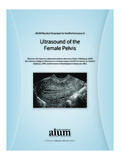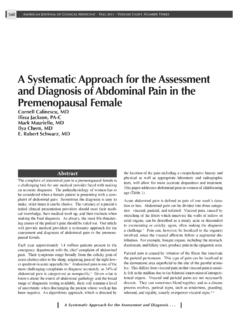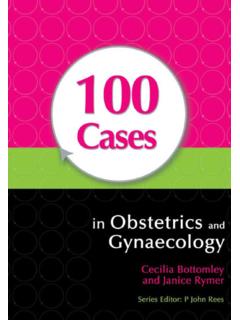Transcription of Antenatal Surgical Management for Ovarian Cysts: …
1 SY YEUNG and JHS LEE. Antenatal Surgical Management for Ovarian Cysts: 13 Years' Experience Suet-Ying YEUNG MBChB, MRCOG. Jacqueline Ho-Sze LEE MBChB, MRCOG, FHKCOG, FHKAM(O&G). Department of Obstetrics and Gynaecology, Prince of Wales Hospital, The Chinese University of Hong Kong, Hong Kong Objective: To evaluate the outcome of surgically treated Ovarian cysts during the Antenatal period in 51 women. Methods: The outcome of pregnant women who underwent surgery during the Antenatal period for Ovarian cyst from January 2003 to December 2015 at a university hospital in Hong Kong was retrospectively reviewed. Operative details, histopathology of the Ovarian cyst , pregnancy complications, and neonatal outcome were assessed. Results: Of 51 women surgically treated for Ovarian cyst during pregnancy, 29 were operated electively in the late first or early second trimester (mean [range] gestational age, 14 [8-22] weeks) and 22 were emergency operations (mean [range] gestational age, 13 [4-32] weeks).
2 There were no intra-operative complications or adverse neonatal outcome. The most common pathology was mature cystic teratoma (22/54, ). Most Ovarian cyst complications occurred between 7 and 13 weeks of gestation ( ) and when the size of the cyst was >6 cm ( ). Conclusion: Elective surgery for Ovarian cyst in the late first or second trimester can be achieved safely with a laparoscopic approach. Ovarian cysts >6 cm are at risk of complications and warrant elective surgery. Accurate diagnosis of Ovarian cyst complications during pregnancy can be made clinically based on symptoms and ultrasonographic findings. Hong Kong J Gynaecol Obstet Midwifery 2017; 17(1):18-23. Keywords: Laparoscopy; Ovarian cysts; Pregnancy; Treatment outcome Introduction for removal of an Ovarian mass from January 2003 to Detection of an adnexal mass during pregnancy December 2015 in our university hospital.
3 Patients'. has increased with the use of routine ultrasound scans baseline characteristics, ultrasound findings, histological to assess fetal viability, growth and morphology. The findings, presenting symptoms, indications for surgery, prevalence of adnexal mass in pregnancy ranges from 1/76 operative details, pregnancy complications and neonatal to 1/2328 deliveries1. Most of the Ovarian cysts detected outcome were retrived. The mean diameter of the Ovarian in early pregnancy are functional cysts that resolve with mass was calculated as the sum of three dimensions of increasing gestation and can be managed conservatively2. the mass divided by three. Term delivery was defined as Nonetheless, some may persist and become clinically delivery after 37 weeks of gestation. significant with a risk of cyst complications. Malignancy is rare; the incidence of Ovarian malignancy in pregnancy The decision to proceed to elective surgery was ranges from to case per 1000 deliveries1.
4 Based on the department protocol and patient choice (Table 1). The decision to proceed to emergency surgery was Although antepartum surgery is generally safe, based on the attending surgeon's clinical and ultrasound adverse maternal and fetal outcomes such as miscarriage, suspicion of complications arising from the Ovarian mass. intrauterine fetal death, and preterm delivery have been reported3. The optimal treatment for a growing adnexal Statistical analysis was performed using the mass during pregnancy remains controversial. Statistical Package for the Social Sciences version (SPSS Inc., Chicago [IL], US). Chi square test was used This study aimed to review the maternal and fetal to analyse categorical variables and t test was used for outcomes in 51 pregnant women who underwent Surgical continuous variables. The significance level was set at treatment for Ovarian cysts.
5 P< Methods We retrospectively reviewed records of all pregnant Correspondence to: Dr Suet-Ying Yeung women who underwent elective or emergency surgery Email: 18 HKJGOM 2017; 17(1). Management of Ovarian Cysts in Pregnancy Results operation in all patients. Suspicious features were detected A total of 51 pregnant women who underwent in 6 patients, one of whom had Ovarian malignancy. All elective (n=29) or emergency (n=22) Ovarian cystectomy patients with benign features on ultrasonography were were identified (Table 2). The mean maternal age and parity confirmed to be benign on final pathology. was years and , respectively. The mean body mass index was kg/m2. The mean gestational age at initial diagnosis was 10. (range, 4-26) weeks. The mean gestational age at the time Ultrasonography was performed before the of operation was (range, 4-32) weeks; weeks for Table 1.
6 Management protocol for Ovarian cysts complicating pregnancy Ovarian cyst Management protocol Simple unilocular cyst Before 16 weeks and size 6 cm Conservative Management unless complications develop Before 16 weeks and size >6 cm, or cyst Counsel patients about pros and cons of surgery during pregnancy and persisting beyond 16 weeks (before 20 weeks) arrange surgery in the second trimester if patient agrees After 20 weeks Conservative Management unless patient is symptomatic Suspicious Ovarian cyst Consult gynaeoncologist for opinion Table 2. Maternal demographics*. Maternal demographic Elective (n=29) Emergency (n=22) All cases (n=51). Maternal age (years) (20-39) (24-40) (20-40). Gravity (0-4) (0-2) (0-4). Parity (0-2) (0-2) (0-2). Multiple pregnancy 0 2 (9) 2 ( ). Body mass index (kg/m2) ( ) ( ) ( ). Gestation at diagnosis (weeks) 10 (5-14) (4-26) (4-26).
7 Gestation at operation (weeks) (8-20) (4-32) (4-32). Time from diagnosis to operation (weeks) (0-15) (0-20) (0-20). *. Data are shown as mean (range) or No. (%) of subjects Table 3. Histological diagnosis of adnexal masses Elective (n=33)* Emergency (n=21) Total Mature cystic teratoma 17 5 22. Corpus luteal cyst 1 6 7. Serous cystadenoma 4 3 7. Endometrioma 5 1 6. Mucinous cystadenoma 5 1 6. Struma ovarii 0 2 2. Fimbrial cyst 0 1 1. Fibrothecoma 1 0 1. Dysgerminoma 0 1 1. Serous adenocarcinoma 0 1 1. *. Four out of 29 cases had bilateral Ovarian cysts . Histology not available in 1 case as only de-torsion was performed HKJGOM 2017; 17(1) 19. SY YEUNG and JHS LEE. elective cases and weeks for emergency cases) The ( ) were Ovarian malignancy (one high-grade serous mean time from initial diagnosis to operation was adenocarcinoma and one dysgerminoma).
8 Weeks. All elective surgeries were performed via a A total of 54 Ovarian cysts were excised because four laparoscopic approach during the first or second trimester, patients had bilateral involvement (Table 3). One patient except that elective laparotomy was performed for one underwent de-torsion of the ovary only. The most common patient suspected of Ovarian malignancy (Table 5). The histology was mature cystic teratoma (n=22, ). Two patient presented at 8 weeks of gestation with right-side abdominal pain; preoperative ultrasonography revealed a 9-cm right unilocular Ovarian cyst with irregular border and Table 4. cyst types by ultrasonographic appearance multiple papillary projections. Owing to suspected Ovarian malignancy, laparotomy with right salpingo-ophorectomy Type No. of cysts (n=54). and peritoneal and omental biopsy were performed.
9 The Benign operation lasted for 60 minutes. No tocolysis was required. Simple The final pathology was endometrioma. For the 28 elective Corpus luteum 7 laparoscopies, the primary entry was made using the Serous cystadenoma 5 Hasson technique via an intraumbilical incision. Ovarian Mucinous cystadenoma 4 cystectomy was performed in 26 cases and salpingo- Struma ovarii 2 ophorectomy in two. The cyst ruptured during the operation Fimbrial cyst 1 in 23 cases. Teratoma Mature cystic teratoma 22. For the 22 emergency surgeries, 13 were laparoscopy and nine were laparotomy (Table 5). All were performed Endometrioma 2. for patients suspected of Ovarian cyst complications. For Mucinous cystadenoma 1. the 13 emergency laparoscopy, the primary entry was made Endometrioma using the Veress needle at 4 weeks and 9 weeks of gestation Endometrioma 2 in two cases, and using the Hasson technique through an Serous cystadenoma 1 intraumbilical incision in 11 cases.
10 Ovarian cystectomy Mucinous cystadenoma 1 was performed in 10 cases, and haemostasis of bleeding Suspicious Ovarian cyst , salpingo-ophorectomy and de-torsion and Endometrioma 2 drainage of the ovary in three cases. Only one patient had Serous adenocarcinoma 1 postoperative urinary tract infection. Dysgerminoma 1. For the nine cases of emergency laparotomy, three Fibrothecoma 1. cases with large cyst size (10-20 cm) were performed in the Serous cystadenoma 1. first trimester, and 6 in the late second or third trimester (17- Table 5. Operative and postoperative details of elective and emergency operations*. Elective Elective Emergency Emergency laparotomy (n=9). laparoscopy laparotomy laparoscopy (n=13). (n=28) (n=1). Operating time (mins) (33-166) 60 (20-170) (30-175). Blood loss (ml) 50 (5-200) 50 (0-50) 60 (5-400). Intra-operative complications 0 0 0 0.)







